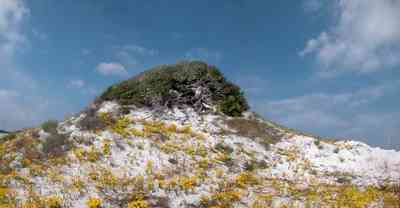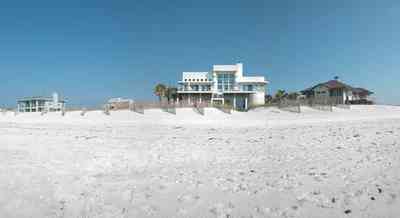-

Dominating the left side of the living room is hte custom maple bar with an inlaid slate top. The sink is copper and the faucet is black onyx. The beautiful crystal barware represents ms. Ritchie's trip as an Armonk scholar to Germany and the Czech republic as well as family heirloom pieces.
-

Beach elder (Iva imbricata) has sparse, woody, upright stems and fleshy narrow bright green leaves. Small lavender flowers occur in late summer. Beach elder accumulates sand rapidly and produces low rounded dunes.
-

-

-

-

-

-

-

-

-

-

There is a wide expanse of beach between the waterfront and the home.
-

Every room has the advantage of a large expanse of windows or skylights on both floors.
-

Dunes on the side and front are held in place by the extensive root system of sea oats.
-

A boardwalk leads from the backporch to the beach.
-

The view is facilitated by glass balcony railings. The fence on the beach is a dune building line trap the blowing sand.
-

The house was rebuilt in 1995. Stainless steel trim and hardware were added to the exterior finishing.
-

The second floor deck wraps around the house and is an extension of the interior living space.
-

A hot tub is sunken into the deck off the master bedroom.
-

The staircase bisects the deck leading to the downstairs living area.
-

-

There is an enclosed patio area on the east side the house.
-

The home faces north on Ariola Drive.
-

The glass brick tower is the dominant feature of the facade. It functions as the enclosure for the circular staircase.
-

Stucco is the exterior finish of the home.
-

A circular staircase connects the guest quarters to the second floor residence.
-

The risers are wood that match the upstairs flooring material.
-

-

The kitchen is located on the west side of the second floor. It features a catering kitchen and wine cooler.
-

The appliances were imported from France.
-

-

The plants grow to 6 feet high and they function to trap wind-blown sands that eventually mound to begin dune formation.
-

White sand makes for emerald green water.
-

This aerial shows the road that goes the length of Santa Rosa Island. All beach areas can be reached by road, but the road can't be seen from the water.
-

The white sand actually traveled from the Appalachian mountains from local rivers. The dunes are tops with a smattering of sea oats.
-

Summer is best for saltwater and beach ativities; fall, winter, and spring are best for birds.
-

The shoreline along the coast is uniform throughout the gulf side of the island.
-

-

-

-

-

-

-

-


 Dominating the left side of the living room is hte custom maple bar with an inlaid slate top. The sink is copper and the faucet is black onyx. The beautiful crystal barware represents ms. Ritchie's trip as an Armonk scholar to Germany and the Czech republic as well as family heirloom pieces.
Dominating the left side of the living room is hte custom maple bar with an inlaid slate top. The sink is copper and the faucet is black onyx. The beautiful crystal barware represents ms. Ritchie's trip as an Armonk scholar to Germany and the Czech republic as well as family heirloom pieces. Beach elder (Iva imbricata) has sparse, woody, upright stems and fleshy narrow bright green leaves. Small lavender flowers occur in late summer. Beach elder accumulates sand rapidly and produces low rounded dunes.
Beach elder (Iva imbricata) has sparse, woody, upright stems and fleshy narrow bright green leaves. Small lavender flowers occur in late summer. Beach elder accumulates sand rapidly and produces low rounded dunes.








 There is a wide expanse of beach between the waterfront and the home.
There is a wide expanse of beach between the waterfront and the home. Every room has the advantage of a large expanse of windows or skylights on both floors.
Every room has the advantage of a large expanse of windows or skylights on both floors. Dunes on the side and front are held in place by the extensive root system of sea oats.
Dunes on the side and front are held in place by the extensive root system of sea oats. A boardwalk leads from the backporch to the beach.
A boardwalk leads from the backporch to the beach. The view is facilitated by glass balcony railings. The fence on the beach is a dune building line trap the blowing sand.
The view is facilitated by glass balcony railings. The fence on the beach is a dune building line trap the blowing sand. The house was rebuilt in 1995. Stainless steel trim and hardware were added to the exterior finishing.
The house was rebuilt in 1995. Stainless steel trim and hardware were added to the exterior finishing. The second floor deck wraps around the house and is an extension of the interior living space.
The second floor deck wraps around the house and is an extension of the interior living space. A hot tub is sunken into the deck off the master bedroom.
A hot tub is sunken into the deck off the master bedroom. The staircase bisects the deck leading to the downstairs living area.
The staircase bisects the deck leading to the downstairs living area.
 There is an enclosed patio area on the east side the house.
There is an enclosed patio area on the east side the house. The home faces north on Ariola Drive.
The home faces north on Ariola Drive. The glass brick tower is the dominant feature of the facade. It functions as the enclosure for the circular staircase.
The glass brick tower is the dominant feature of the facade. It functions as the enclosure for the circular staircase. Stucco is the exterior finish of the home.
Stucco is the exterior finish of the home. A circular staircase connects the guest quarters to the second floor residence.
A circular staircase connects the guest quarters to the second floor residence. The risers are wood that match the upstairs flooring material.
The risers are wood that match the upstairs flooring material.
 The kitchen is located on the west side of the second floor. It features a catering kitchen and wine cooler.
The kitchen is located on the west side of the second floor. It features a catering kitchen and wine cooler. The appliances were imported from France.
The appliances were imported from France.
 The plants grow to 6 feet high and they function to trap wind-blown sands that eventually mound to begin dune formation.
The plants grow to 6 feet high and they function to trap wind-blown sands that eventually mound to begin dune formation. White sand makes for emerald green water.
White sand makes for emerald green water. This aerial shows the road that goes the length of Santa Rosa Island. All beach areas can be reached by road, but the road can't be seen from the water.
This aerial shows the road that goes the length of Santa Rosa Island. All beach areas can be reached by road, but the road can't be seen from the water. The white sand actually traveled from the Appalachian mountains from local rivers. The dunes are tops with a smattering of sea oats.
The white sand actually traveled from the Appalachian mountains from local rivers. The dunes are tops with a smattering of sea oats. Summer is best for saltwater and beach ativities; fall, winter, and spring are best for birds.
Summer is best for saltwater and beach ativities; fall, winter, and spring are best for birds. The shoreline along the coast is uniform throughout the gulf side of the island.
The shoreline along the coast is uniform throughout the gulf side of the island.







 One Tank of Gas
One Tank of Gas